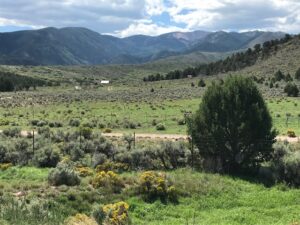
The Nevada side of the Virgin River Gorge
Even the thin, muddy, Virgin River, trickling slowly from the Utah highlands seems to know that Nevada is where water goes to die.
There is no state boundary located more perfectly to separate “here” from”there” than the Virgin River Gorge, a deep slice through a short mountain range between Mesquite, Nevada and St. George, Utah. On the west, southern Nevada stretches out in desiccated playas, burnt alluvium, and hopeless horizons of brown, dusty, brown, sandy, brown. This is the hard desert that oases have forgotten. Growing season here may be 15 minutes after a years’ only thunderstorm. Were it not for a six and a half million tons of concrete damming the Colorado River, or what is left of it, even Las Vegas would not interrupt this emptiness running nearly to Los Angeles.
Southern Nevada is not bad, or even ugly; just incredibly inhospitable to living things. Even the thin, muddy, Virgin River, trickling slowly from the Utah highlands seems to know that Nevada is where water goes to die.

Utah north of St. George
Less than a mile east through the Gorge, proud, stout, broad buttresses of majestic red sandstone and castle-like gray limestone promise the unique multi-layered vistas of Utah: grand canyons, monumental valleys, green bottomland, and lofty arches rising to Zion. Had I been a First American hunter or a pilgrim pioneer, pushing westward by the promise of new lands, I would have taken one brief peek through the western gates of the Virgin River Gorge, turned my back to the setting sun, and run like hell back to where I had come from.
I will be back in Nevada and Utah later in the fall; tomorrow I make it up into Wyoming for the first interviews of the trip!











Leave A Comment